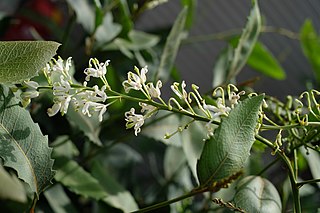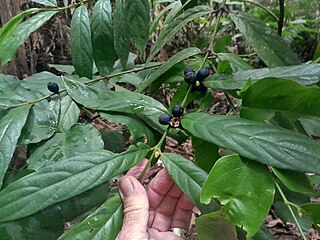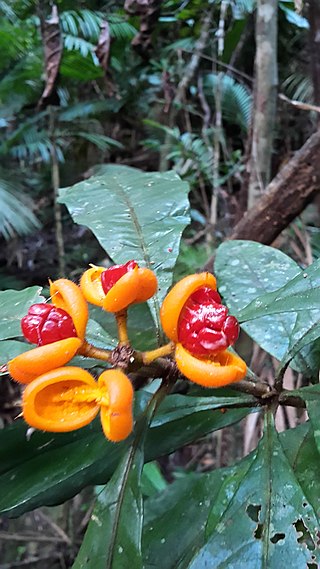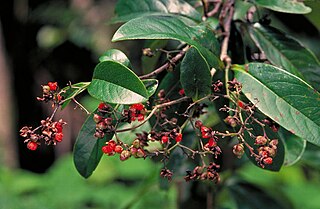
Aphanopetalum is a genus of twining shrubs or vines in the family Aphanopetalaceae which are endemic to Australia.

Atractocarpus chartaceus, commonly known as the narrow-leaved gardenia, is a species of evergreen flowering plant in the coffee family Rubiaceae. It is found in subtropical rainforest of eastern Queensland, Australia, and it is cultivated for its fragrant flowers and colourful fruit.

Phaleria clerodendron, commonly known as scented daphne, scented phaleria or rosy apple, is an evergreen tree or tall shrub in the family Thymelaeaceae. It is endemic to the rainforests of north-eastern Queensland, Australia.

Pseuderanthemum variabile, commonly known as pastel flower or love flower in its native range, or night and afternoon in the USA, is a small perennial herb in the family Acanthaceae which is native to Australia, Papua New Guinea and New Caledonia. It can be an unwelcome nuisance in orchid nurseries in Australia.

Lomatia ilicifolia, commonly known as holly lomatia or native holly, is a plant in the family Proteaceae and is endemic to south-eastern Australia. It is a stiff, erect shrub with hairy, rust-coloured new growth and which recovers from fire from a lignotuber. It has dull green, leathery, prickly, holly-like leaves and long sprays of cream flowers, usually after fire.

Cordyline manners-suttoniae, commonly known as the giant palm lily, is an evergreen plant found only in rainforest of northeastern Queensland, Australia.

Olearia asterotricha, commonly known as rough daisy-bush, is a species of flowering plant in the family Asteraceae. A tall shrub with white, mauve or blue daisy like flowers growing from the Blue Mountains in New South Wales to western Victoria, Australia.

Syzygium canicortex, commonly known as yellow satinash, is a tree in the family Myrtaceae native to Queensland, Australia, first described in 1983.

Olearia ciliata, commonly known as the fringed daisy bush, is a small shrub with large clusters of bright purple-blue flowers on a single stem.

Pimelea curviflora, also known as curved rice-flower, is a shrub in the family Thymelaeaceae and is endemic to Australia. It is a small, hairy shrub with greenish-yellow or red tubular flowers.

Cheiranthera linearis, commonly known as finger-flower, is a flowering plant in the family Pittosporaceae. It is a small shrub with deep purple flowers, yellow stamens and dull green linear shaped leaves. It is found growing in New South Wales, Victoria and Queensland.

Diploglottis harpullioides, commonly known as Babinda tamarind, is a rainforest tree in the lychee and maple family Sapindaceae which is found only in northeast Queensland, Australia.

Meiogyne hirsuta is a plant in the custard apple family Annonaceae endemic to the Wet Tropics bioregion of Queensland, Australia. It is known from only a small number of collections from three widely separated locations.

Cleistanthus apodus, commonly known as the weeping Cleistanthus, is a tree in the family Phyllanthaceae native to New Guinea and northeast Queensland. It was first described in 1873 by the English botanist George Bentham in his seven-volume book Flora Australiensis.

Lasianthus chlorocarpus, commonly known as blue rubi, is a plant in the family Rubiaceae native to parts of Malesia, Papuasia and Australia. It is an evergreen shrub growing up to 2 m high in well developed rainforest.

Pittosporum rubiginosum, commonly known as hairy red pittosporum, is an evergreen shrub in the family Pittosporaceae which is endemic to northeastern Queensland, Australia. It was first described in 1840.

Leea nova-guineensis, commonly known as bandicoot berry, is a plant in the family Vitaceae native to parts of Malesia and Oceania.

Peripentadenia phelpsii is a plant in the family Elaeocarpaceae which is endemic to a very small part of northeastern Queensland, Australia. It is a large evergreen tree with large buttresses, and was first described in 1982.

Tetracera daemeliana, commonly known as large-leaved fire vine, is a vine in the guinea flower family Dilleniaceae first described in 1886, which is endemic to the northern half of Queensland, Australia. The flowers are pleasantly perfumed.

Tetracera nordtiana, commonly known as small-leaved fire vine, is a climbing plant in the family Dilleniaceae which occurs from eastern Indonesia to the Australian state of Queensland. It was first described in 1865 and has a conservation status of least concern.






















